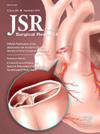Negative Pressure Dressing Versus Conventional Passive Dressing in Pilonidal Surgery: A Randomized Controlled Trial
IF 1.8
3区 医学
Q2 SURGERY
引用次数: 0
Abstract
Introduction
Surgically treated pilonidal sinus disease (PSD) has high rates of postoperative wound complications, with surgical wound dehiscence (SWD) rates up to 44%. Negative pressure wound therapy (NPWT) is proposed to reduce rates of SWD for other high risk surgical wounds. Our aim was to investigate whether NPWT would reduce rates of SWD compared to conventional passive (CP) dressings for PSD excisions with off-midline primary closure. Our secondary outcomes included patient quality of life and time taken return to normal activities.
Method
We performed a prospective, crossover pediatric/adult randomized controlled trial for patients (12-40 y) with PSD, requiring excision and off-midline primary closure. Participants were randomized to receive a CP (Primapore or Opsite) or NPWT (SNAP) dressing. Follow-up occurred on D3, D7, D10, D14 and then weekly until wound healing. Patients were sent a 2-month postoperative online survey to assess quality of life outcomes.
Results
Fifty patients were recruited, 25 to NPWT & 25 to CP. Mean age and body mass index were 22.6 ± 6.7 y and 26.1 ± 4.5 kg/m2, respectively. 36/50 (76%) were male. The overall dehiscence rate was 42% (21/50); 12/25 (48%) for NPWT & 9/25 (36%) for CP, P = 0.6. Five deep (≥5 mm) SWDs occurred in each group, P > 0.9. SWD was associated with increased excision dimensions in the NPWT group only, P = 0.03. Median duration to wound healing was equivalent in nondehisced wounds, (CP 21.0 [14.0-29.5] versus NPWT 21.0 [16.0-24.0] days, P = 0.7). There were no differences in mean time to the following: return to school/work (NPWT 26.1 ± 18.2 versus CP 29.3 ± 14.7 d, P = 0.6), sit normally (NPWT 22.3 ± 16.2 versus CP 20.1 ± 9.4 d, P = 0.7), or return to physical activity (NPWT21.6 ± 17.2 versus CP40.3 ± 2.4 d, P = 0.2).
Conclusions
NPWT did not improve outcomes after excision of PSD with off-midline primary closure. Despite the limited population size, our results do not support its use as a routine preventative measure.
蝶窦手术中负压敷料与传统被动敷料的对比:随机对照试验
简介:经手术治疗的朝天鼻窦疾病(PSD)的术后伤口并发症发生率很高,手术伤口开裂率(SWD)高达 44%。负压伤口疗法(NPWT)可降低其他高风险手术伤口的开裂率。我们的目的是研究与传统的被动(CP)敷料相比,负压伤口疗法是否能降低PSD切除术中线外初次闭合的SWD发生率。我们的次要研究结果包括患者的生活质量和恢复正常活动所需的时间:我们对需要进行切除术和中线外初次闭合的 PSD 患者(12-40 岁)进行了一项前瞻性、交叉性儿童/成人随机对照试验。参与者被随机分配接受 CP(Primapore 或 Opsite)或 NPWT(SNAP)敷料。随访时间为第 3 天、第 7 天、第 10 天、第 14 天,之后每周随访一次,直至伤口愈合。患者会收到一份为期 2 个月的术后在线调查,以评估其生活质量:共招募了 50 名患者,其中 25 人接受 NPWT 治疗,25 人接受 CP 治疗。平均年龄和体重指数分别为 22.6 ± 6.7 岁和 26.1 ± 4.5 kg/m2。36/50(76%)为男性。总体开裂率为42%(21/50);NPWT为12/25(48%),CP为9/25(36%),P = 0.6。每组均有 5 例深度(≥5 毫米)SWD,P > 0.9。只有 NPWT 组的 SWD 与切除尺寸增加有关,P = 0.03。非开裂伤口的中位愈合时间相当(CP 21.0 [14.0-29.5] 天与 NPWT 21.0 [16.0-24.0] 天,P = 0.7)。以下方面的平均时间没有差异:重返学校/工作(NPWT 26.1 ± 18.2 与 CP 29.3 ± 14.7 天,P = 0.6)、正常坐姿(NPWT 22.3 ± 16.2 与 CP 20.1 ± 9.4 天,P = 0.7)或恢复体力活动(NPWT 21.6 ± 17.2 与 CP 40.3 ± 2.4 天,P = 0.2):结论:NPWT并未改善PSD切除术后的预后。结论:NPWT 并未改善 PSD 切除术和中线外初次闭合术后的疗效。尽管适用人群有限,但我们的结果并不支持将其作为常规预防措施。
本文章由计算机程序翻译,如有差异,请以英文原文为准。
求助全文
约1分钟内获得全文
求助全文
来源期刊
CiteScore
3.90
自引率
4.50%
发文量
627
审稿时长
138 days
期刊介绍:
The Journal of Surgical Research: Clinical and Laboratory Investigation publishes original articles concerned with clinical and laboratory investigations relevant to surgical practice and teaching. The journal emphasizes reports of clinical investigations or fundamental research bearing directly on surgical management that will be of general interest to a broad range of surgeons and surgical researchers. The articles presented need not have been the products of surgeons or of surgical laboratories.
The Journal of Surgical Research also features review articles and special articles relating to educational, research, or social issues of interest to the academic surgical community.

 求助内容:
求助内容: 应助结果提醒方式:
应助结果提醒方式:


